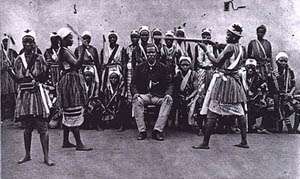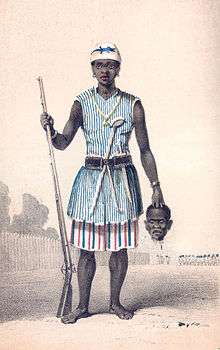Dahomey Amazons
The Dahomey Amazons or N'Nonmiton, which means "our mothers" in Fon, were a Fon all-female military regiment of the Kingdom of Dahomey in the present-day Republic of Benin which lasted until the end of the 19th century. They were so named by Western observers and historians due to their similarity to the semi-mythical Amazons of ancient Anatolia and the Black Sea.
Origin

King Houegbadja (who ruled from 1645 to 1685), the third King of Dahomey, is said to have originally started the group which would become the Amazons as a corps of elephant hunters called the gbeto.[1](p20)
Houegbadja's son King Agaja (ruling from 1708 to 1732) established a female bodyguard armed with muskets. European merchants recorded their presence. According to tradition, Agaja developed the bodyguard into a militia and successfully used them in Dahomey's defeat of the neighbouring kingdom of Savi in 1727.[2] The group of female warriors was referred to as N'Nonmiton, meaning "Our Mothers" in the Fon language, by the male army of Dahomey.[1](p44)
From the time of King Ghezo (ruling from 1818 to 1858), Dahomey became increasingly militaristic. Ghezo placed great importance on the army, increasing its budget and formalizing its structure from ceremonial to a serious military. While European narratives refer to the women soldiers as "Amazons," they called themselves ahosi (king's wives) or N'Nonmiton (our mothers).[2]
Recruitment

Ghezo recruited both men and women soldiers from foreign captives, though women soldiers were also recruited from free Dahomian women, some enrolled as young as 8 years old.[2] Other accounts indicate that the N'Nonmiton were recruited from among the ahosi ("king's wives") of which there were often hundreds.[1](p38) Some women in Fon society became soldiers voluntarily, while others were involuntarily enrolled if their husbands or fathers complained to the king about their behaviour.
Membership among the N'Nonmiton was supposed to hone any aggressive character traits for the purpose of war. During their membership they were not allowed to have children or be part of married life (though they were legally married to the king). Many of them were virgins. The regiment had a semi-sacred status, which was intertwined with the Fon belief in Vodun.
The N'Nonmiton trained with intense physical exercise. They learnt survival skills and indifference to pain and death, storming acacia-thorn defenses in military exercises and executing prisoners.[3] Discipline was emphasised.
Serving in the N'Nonmiton offered women the opportunity to "rise to positions of command and influence" in an environment structured for individual empowerment.[2] The N'Nonmiton were also wealthy and held high status.[3]
Political role
The N'Nonmiton took a prominent role in the Grand Council, debating the policy of the kingdom. From the 1840s to 1870s (when the opposing party collapsed), they generally supported peace with Abeokuta and stronger commercial relations with England, favouring the trade in palm oil above that in slaves; this set them at odds with their male military colleagues.[4]
Apart from the Council, the Annual Customs of Dahomey included a parade and reviewing of the troops, and the troops swearing of an oath to the king. The celebrations on the 27th day of the Annual Customs consisted of a mock battle in which the N'Nonmiton attacked a "fort" and "captured" the slaves within,[4] a custom recorded by the priest Francesco Borghero in his diaries.[3]
Combat and structure
The women soldiers were rigorously trained, given uniforms, and equipped with Danish guns (obtained via the slave trade). By the mid-19th century, they numbered between 1,000 and 6,000 women, about a third of the entire Dahomey army, according to reports written by visitors. The reports also noted variously that the women soldiers suffered several defeats, but that the women soldiers were consistently judged to be superior to the male soldiers in effectiveness and bravery.[2]
The women soldiers were said to be structured in parallel with the army as a whole, with a center wing (the king's bodyguards) flanked on both sides, each under separate commanders. Some accounts note that each male soldier had a N'Nonmiton counterpart.[2]
In the latter period, the N'Nonmiton were armed with Winchester rifles, clubs and knives. Units were under female command. Captives who fell into the hands of the N'Nonmiton were often decapitated.
Conflict with neighbouring kingdoms
The Dahomey kingdom was often at war with its neighbours, and captives were needed for the slave trade. The N'Nonmiton fought in slave raids, and in the unsuccessful wars against Abeokuta.
Conflict with France
European encroachment into West Africa gained pace during the latter half of the 19th century, and in 1890 King Béhanzin started fighting French forces in the course of the First Franco-Dahomean War. According to Holmes, many of the French soldiers fighting in Dahomey hesitated before shooting or bayoneting the N'Nonmiton. The resulting delay led to many of the French casualties. By the end of the Second Franco-Dahomean War, special units of the Amazons were being assigned specifically to target French officers.[5]
Ultimately, bolstered by the Foreign Legion, and armed with superior weaponry, including machine guns, along with cavalry and Marine infantry, the French inflicted casualties that were ten times worse on the Dahomey side. After several battles, the French prevailed in the Second Franco-Dahomean War. The legionnaires later wrote about the "incredible courage and audacity" of the Amazons.
Disbandment
._-_The_veteran_amazones(_AHOSI_)_of_the_Fon_king_B%C3%A9hanzin%2C_Son_of_Roi_G%C3%A9l%C3%A9.jpg)
The troops were disbanded when the kingdom became a French protectorate.[6]
The last survivor of the Dahomey Amazons is thought to have been a woman named Nawi. In a 1978 interview with a Beninese historian, she claimed to have fought the French in 1892. She died in November 1979, aged well over 100.[3]
In popular culture
Dahomey Amazons were represented in the 1987 film Cobra Verde by German director Werner Herzog. Ghezo's Amazons play a significant role in the novel Flash for Freedom! by George MacDonald Fraser.
The unit is also depicted in (a special edition of, and now DLC of) PC game Empire: Total War.
A segment of QI Series 7 Episode 7 discussed Dahomey Amazons and showed a photo.
Referenced in Stieg Larsson's novel The Girl Who Kicked the Hornets' Nest in the prelude to Part 4 Rebooting System.
The warriors are also mentioned in Patrick O'Brian's novel The Commodore, book 17 of the Aubrey-Maturin series.
The main character of Charles R. Saunders fantasy novel Dossouye, an ahosi of Abomey, is closely modelled on the Dahomey ahosi.
P. C. Wren's 1917 book of short stories Stepsons of France contains a story called "Here are Ladies," describing a series of clashes between troops of the Foreign Legion and the Dahomey Amazons.
See also
| Wikimedia Commons has media related to Amazons of Dahomey. |
References
- 1 2 3 Alpern, Stanley B. (1999). Amazons of Black Sparta: The Women Warriors of Dahomey. New York: New York University Press. ISBN 0-8147-0678-9.
- 1 2 3 4 5 6 Law, Robin (1993). "The 'Amazons' of Dahomey". Paideuma. 39: 245–260. JSTOR 40341664.
- 1 2 3 4 "Dahomey's Women Warriors | Past Imperfect". Blogs.smithsonianmag.com. Retrieved 2013-01-12.
- 1 2 Yoder, John C. (1974). "Fly and Elephant Parties: Political Polarization in Dahomey, 1840–1870". The Journal of African History. 15 (3): 417–432. doi:10.1017/s0021853700013566.
- ↑ Amazons of Black Sparta. Stanley B. Alpern. London, 1998, p. 203 and 205
- ↑ "The Amazons". Epa-prema.net. Retrieved 2016-10-03.
Bibliography
- Warrior Women: The Amazons of Dahomey and the Nature of War. Robert B. Edgerton. Boulder: Westview Press, 2000
- Amazons of Black Sparta. Stanley B. Alpern. London, 1998
- Wives of the Leopard: Gender, Culture, and Politics in the Kingdom of Dahomey. Edna G. Bay. Charlottesville, 1998
- A Mission to Gelele, King of Dahome. Richard Burton, London, 1864
- Women Warlords: An Illustrated Military History of Female Warriors. Tim Newark and Angus McBride, Blandford Press, 1989 ISBN 0-7137-1965-6
- Acts of War: the behavior of men in battle. Holmes R. New York, Free Press, 1985
- On Killing: The Psychological Cost of Learning To Kill in War and Society. Grossman D. New York, Back Bay Books / Little, Brown and Company, 1995 ISBN 0-316-33011-6 pp. 175
- Der Atlantische Sklavenhandel von Dahomey, W. Peukert, 1740–1797, Wiesbaden, 1978
- (UNUSED)Les Amazones: Une Armée de Femmes dans l’Afrique Précoloniale, Hélène Almeida-Topor, Paris, Editions Rochevignes, 1984